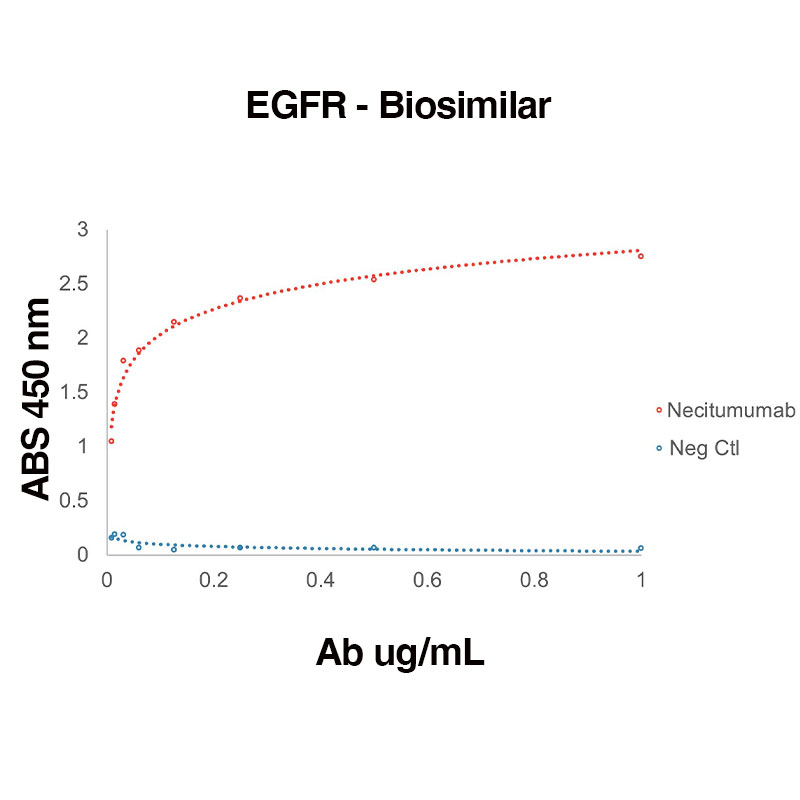Anti-Human EGFR (Necitumumab)
Antibody Isotype:
Human IgG1κ
Antibody Clonality:
Monoclonal
Applications:- Enzyme-Linked Immunosorbent Assay (ELISA)
- Flow Cytometry
- Functional Study
- Immunoprecipitation (IP)
- Western Blot (WB)
Shipping:
2 - 8°C Wet Ice
Storage:
Functional grade biosimilar antibodies may be stored sterile as received at 2-8°C for up to one month. For longer term storage aseptically aliquot in working volumes without diluting and store at -80°C. Avoid Repeated Freeze Thaw Cycles.
No additional charges, what you see is what you pay! *
Stay in control of your spending. These prices have no additional charges, not even shipping!
* Rare exceptions are clearly labelled (only 0.14% of items!).
Multibuy discounts available!
Contact us to find what you can save.
This product comes from:
US.
Typical lead time:
14-21 working days.
Contact us for more accurate information.
- Further Information
- References
- Show All
Further Information
EGFR is overexpressed on the cell surfaces of various tumor cell types and is also found in the plasma membranes, cytoplasm, and cell junctions of many healthy tissues, including those associated with the Skin ? Epidermis development cluster of The Human Protein Atlas. EGFR is also found in the blood secretome.
? 5.0 mg/ml
Purified No Carrier Protein
This biosimilar antibody is aseptically packaged and formulated in 0.01 M phosphate buffered saline (150 mM NaCl) PBS pH 7.2 - 7.4 with no carrier protein, potassium, calcium or preservatives added. Due to inherent biochemical properties of antibodies, certain products may be prone to precipitation over time. Precipitation may be removed by aseptic centrifugation and/or filtration.
This biosimilar antibody is aseptically packaged and formulated in 0.01 M phosphate buffered saline (150 mM NaCl) PBS pH 7.2 - 7.4 with no carrier protein, potassium, calcium or preservatives added. Due to inherent biochemical properties of antibodies, certain products may be prone to precipitation over time. Precipitation may be removed by aseptic centrifugation and/or filtration.
Human EGFR/ErbB1
Epidermal growth factor receptor (EGFR, also known as ErbB1 or HER-1) belongs to the receptor tyrosine kinase superfamily and is a transmembrane glycoprotein that activates various signaling pathways fundamental to cellular proliferation, differentiation, and survival1, 2. EGFR plays important roles during embryogenesis, organogenesis, and in the growth, differentiation, maintenance, and repair of adult tissues2, including autophagy3. EGFR is also a host factor that facilitates viral entry for hepatitis B4, hepatitis C5, and gastroenteritis6 and plays a role in SARS-CoV-2 infection7, 8, 9. Dysregulation, somatic mutation, and/or altered signaling of EGFR are associated with disease (Parkinson?s2, Alzheimer?s1,2, and amyotrophic lateral sclerosis2) and various cancers (lung, glioblastoma, brain, breast, colorectal, ovarian)3. Additionally, in cancer, aberrant activation of EGFR is associated with increased cell proliferation, invasion, metastasis, angiogenesis, and decreased apoptosis10. As such, EGFR is the target of multiple cancer therapies, including monoclonal humanized antibodies, such as necitumumab, as well as selective small molecule inhibitors.
Necitumumab inhibits EGFR-dependent tumor cell proliferation and metastasis11 by acting as an EGFR antagonist that binds specifically and with high affinity to human EGFR, thereby blocking ligand binding and neutralizing ligand-induced EGFR phosphorylation and downstream signaling pathways10, 11, 12. Anti-tumor activity has been demonstrated in vitro and in vivo 10, and necitumumab is FDA approved for treatment of adult patients with locally advanced or metastatic EGFR-expressing squamous non-small cell lung cancer11. In vitro studies have shown that necitumumab induces internationalization and degradation of EGFR, leading to antibody-dependent cellular cytotoxicity in EGFR-expressing cells10, 11. Necitumumab was generated from the Dyax Corp proprietary phage display library by ImClone Systems, a wholly owned subsidiary of Eli Lilly10.
1956
?95% by SDS Page, ?95% monomer by analytical SEC
EGFR



